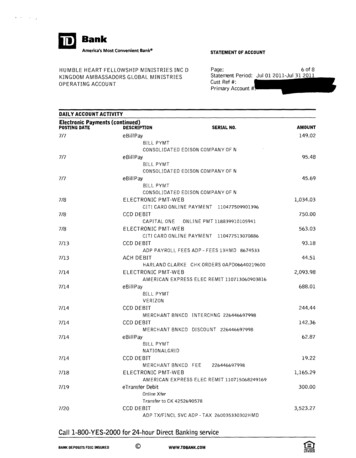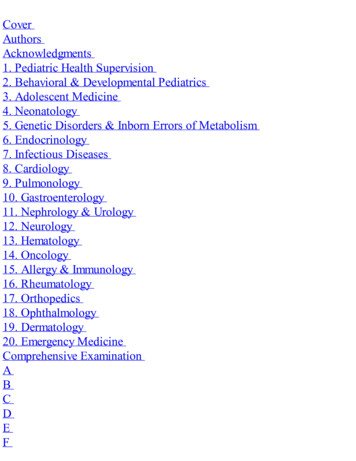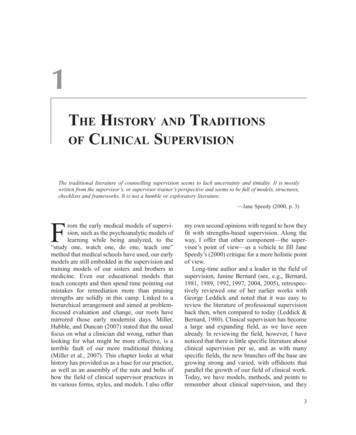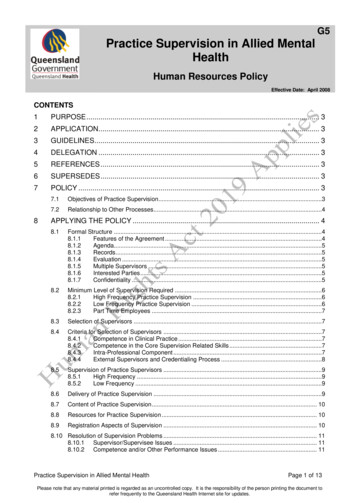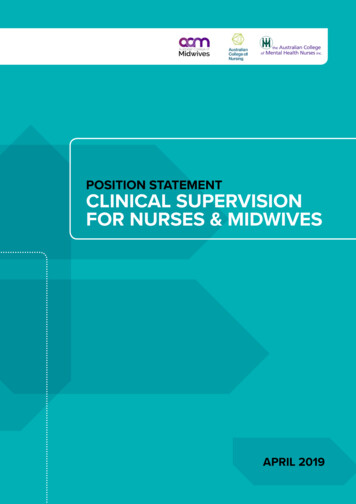
Transcription
POSITION STATEMENTCLINICAL SUPERVISIONFOR NURSES & MIDWIVESAPRIL 2019
Position statement: Clinical Supervision for Nurses & Midwives 2019 waspublished by the Australian College of Mental Health Nurses, Australian Collegeof Midwives, and Australian College of Nursing and is available at each of thecollege websites:Australian College of Mental Health Nurses http://www.acmhn.org/Australian College of Midwives https://www.midwives.org.au/Australian College of Nursing https://www.acn.edu.au/ISBN: 978-1-925913-58-3 (e-book)ISBN: 978-1-925913-6-5 (Pamphlet)ACKNOWLEDGEMENTSThis position statement was developed by a joint working group ofrepresentatives from each college:Patricia Bradley, RN, RPN, PhD, Grad Dip Health Ed, FACMHN.Ruth King, Midwife, BMid, BMid (Hons), CertIV TAE, MACM.Bev Love, Midwife, BN, CertIV Instructional Skills, Clinical Supervisor RoleDevelopment Model (Endorsed program), MACM, MACSA.Peta Marks, RN, BN, MPH, MCFT, Credentialed MHN, FACMHN.Stacie Murphy, Policy Officer, Australian College of NursingJulie Sharrock, RN, CritCareCert, PsychNursCert, BEd, MHSc(Psych Nurs),AdvDip Gestalt Therapy, PhD Candidate, FACMHN, MACN, MACSA.Carolyn Stapleton, PhD, FACN.Sarah Stewart RN, Midwife, DPSM, BSC(Hons), GCTTL, MA, MBA.
POSITION STATEMENTCLINICAL SUPERVISION FOR NURSES & MIDWIVESClinical Supervision for Nurses & MidwivesPOSITION STATEMENTKEY STATEMENTClinical Supervision is increasingly recognised as a core component of professional support for contemporary nursingand midwifery practice.¹ There is consistent evidence that effective Clinical Supervision impacts positively on theprofessional development as well as the health and wellbeing of supervisees.2-16 The health and wellbeing of nursesand midwives is vital for recruitment and retention and ultimately a healthy and sustainable workforce. There is alsoemerging evidence that Clinical Supervision of health-care staff impacts positively on outcomes for service-users.17-19DEFINITIONClinical Supervision is a formally structured professional arrangement between a supervisor and one or more supervisees.It is a purposely constructed regular meeting that provides for critical reflection on the work issues brought to that spaceby the supervisee(s). It is a confidential relationship within the ethical and legal parameters of practice. Clinical Supervisionfacilitates development of reflective practice and the professional skills of the supervisee(s) through increased awarenessand understanding of the complex human and ethical issues within their workplace.Clinical Supervision as it is understood in this Position Statement is distinct from Point of Care Supervision, FacilitatedProfessional Development, Professional Supervision, Operational Management Processes, Clinical ManagementProcesses, and Personal Staff Support.A trusting alliance between the supervisee(s) and supervisor is the central element of effective Clinical Supervision. Todevelop and maintain this alliance Clinical Supervision: is conducted in regular, private and protected time, away from the practice setting; as effective communication and feedback at its core, is supportive, facilitative and focused on the work issueshbrought to the session by the supervisee(s); i s an opportunity to talk about the realities, challenges and rewards of practice and to be attentively heard andunderstood by another professional; facilitates supervisee self-monitoring and self-accountability and involves the supervisee learning to be a reflectivepractitioner; is predictable and consistent with thoughtful and clear structures, boundaries, processes and goals; develops knowledge and confidence with a strengths-focus aimed at building supervisee practice skills andawareness of practice; is a culturally safe and respectful relationship that has commitment from both the supervisor and supervisee(s); is supported by an agreement that is reviewed regularly and includes the extent and limits of confidentiality; is confidential within the ethical and legal boundaries of nursing and midwifery practice; supports supervisees to choose their supervisors; is provided by professionals who have undertaken specific training in Clinical Supervision and engage in their ownregular Clinical Supervision; is not provided by a professional who has organisational responsibility to direct, coordinate or evaluate theperformance of the .acmhn.orgPage 2
POSITION STATEMENTCLINICAL SUPERVISION FOR NURSES & MIDWIVESPOSITION STATEMENTIt is the position of the Australian College of Nursing, the Australian College of Mental Health Nurses and the AustralianCollege of Midwives that Clinical Supervision is recommended for all nurses and midwives irrespective of their specificrole, area of practice and years of experience.TO ACHIEVE THIS POSITION, IT IS RECOMMENDED THAT:1. Clinical Supervision is embedded in all nursing and midwifery undergraduate and vocational education as acomponent of professional practice.2. nurses and midwives are fully orientated to Clinical Supervision upon entry to their relevant workforce and haveAllaccess to Clinical Supervision that meets their individual needs.3. Clinical Supervisors of individuals and groups undertake specific educational preparation for this role and engageAllin their own regular Clinical Supervision.4. The nursing and midwifery professional bodies advocate for a national standard for educational preparation ofClinical Supervisors.5. employers of nurses and midwives positively support and actively promote quality Clinical Supervision throughAllorganisational policies, procedures and workplace culture.6. Regular systematic evaluations of the quality and efficacy of Clinical Supervision arrangements are undertaken at thelocal service level, taking care not to compromise the integrity of confidentiality agreements between supervisorsand supervisees.7. The nursing and midwifery professional bodies advocate for investment in robust Clinical Supervision programsthroughout the health and aged care systems to support implementation and sustainability.8. Thenursing and midwifery professional bodies advocate for investment in outcomes-related research to strengthenthe Clinical Supervision evidence base and for continuous improvement.9. The nursing and midwifery professional bodies collaborate with industrial associations to incorporate ClinicalSupervision within Enterprise Bargaining Agreements.10. The nursing and midwifery professional bodies take an active role in interdisciplinary collaboration and advocacy forClinical Supervision.REFERENCES1. Thoms D. Take on burnout together. Nursing Review; 2014.2. BamblingM. Supervision outcomes. Clinical ‘SUPER’vision: power passion purpose. Australian Nursing and Midwifery House, Melbourne,Victoria, Australia: Australian Clinical Supervision Association; 2018.3. BruneroS, Stein-Parbury J. The effectiveness of clinical supervision in nursing: an evidenced based literature review. Australian Journal ofAdvanced Nursing. 2008;25(3):86-94.4. ButterworthT, Bell L, Jackson C, Pajnkihar M. Wicked spell or magic bullet? A review of the clinical supervision literature 2001-2007. NurseEducation Today. 2008;28(3):264-272.5. CarpenterJ, Webb CM, Bostock L. The surprisingly weak evidence base for supervision: Findings from a systematic review of research inchild welfare practice (2000–2012). Children & Youth Services Review. 2013;35(11):1843-1853.6. Cummins A. Clinical supervision: the way forward? A review of the literature. Nurse Education in Practice. 2009;9(3):215-220.7. Cutcliffe J, Sloan G, Bashaw M. A systematic review of clinical supervision evaluation studies in nursing. International Journal of MentalHealth Nursing. 2018;27(5):1344–1363.8. DilworthS, Higgins I, Parker V, Kelly B, Turner J. Finding a way forward: A literature review on the current debates around clinicalsupervision. Contemporary Nurse. 2013;45(1):22-32.9. Le LK-D. Evidence summary. Nursing: Clinical supervision: The Joanna Briggs Institute EBP; 2017.10. MartinP, Copley J, Tyack Z. Twelve tips for effective clinical supervision based on a narrative literature review and expert opinion. MedicalTeacher. auwww.acmhn.orgPage 3
POSITION STATEMENTCLINICAL SUPERVISION FOR NURSES & MIDWIVES11. Sirola-KarvinenP, Hyrkäs K. Clinical supervision for nurses in administrative and leadership positions: a systematic literature review of thestudies focusing on administrative clinical supervision. Journal of Nursing Management. 2006;14(8):601-609.12. Watkins CE. Does psychotherapy supervision contribute to patient outcomes? Considering thirty years of research. The Clinical Supervisor.2011;30(2):235-256.13. Wheeler S, Richards K. The impact of clinical supervision on counsellors and therapists, their practice and their clients. A systematic reviewof the literature. Counselling & Psychotherapy Research. 2007;7(1):54-65.14. White E, Winstanley J. Clinical Supervision for mental health professionals: The evidence base. Social Work and Social Sciences Review.2011;14(3):77-94.15. MacLaren J, Stenhouse R, Ritchie D. Mental health nurses’ experiences of managing work- related emotions through supervision. Journal ofAdvanced Nursing. 2016;72(10):2423-2434.16. Turner J, Mackenzie L, Kelly B, Clarke D, Yates P, Aranda S. Building psychosocial capacity through training of front-line health professionalsto provide brief therapy: lessons learned from the PROMPT study. Supportive Care in Cancer. 2018;26(4):1105-1112.17. BamblingM, King R, Raue P, Schweitzer R, Lambert W. Clinical supervision: Its influence on client-rated working alliance and client symptomreduction in the brief treatment of major depression. Psychotherapy Research. 2006;16(3):317-331.18. Bradshaw T, Butterworth A, Mairs H. Does structured clinical supervision during psychosocial intervention education enhance outcome formental health nurses and the service users they work with? Journal of Psychiatric & Mental Health Nursing. 2007;14(1):4-12.19. White E, Winstanley J. A randomised controlled trial of clinical supervision: selected findings from a novel Australian attempt to establishthe evidence base for causal relationships with quality of care and patient outcomes, as an informed contribution to mental health nursingpractice development. Journal of Research in Nursing. auwww.acmhn.orgPage 4
CLINICAL SUPERVISION FOR NURSES & MIDWIVESBACKGROUND PAPERClinical Supervision for Nurses & MidwivesBACKGROUND PAPERClinical Supervision has an established history in health-care professions including psychotherapy, counselling, socialwork, psychology and psychiatry.1 North American nurses began developing their ideas as early as 19252 and thenursing literature in relation to Clinical Supervision has grown significantly.3 The literature base from all disciplines isnow extensive.4, 5Clinical Supervision has been a regular focus of discourse in relation to mental health nursing and it is increasingly beingregarded as important for all nurses and midwives regardless of what area, role, level or model of care they work in.3, 5-17The capacity to reflect on practice is a desired aspect of nursing and midwifery18 and has been identified as a corecharacteristic of the expert nurse and midwife.19 Reflection and Clinical Supervision is referenced in key documentsrelated to nurses and midwives.20-32TERMINOLOGYIt is acknowledged that the term Clinical Supervision has been identified as problematic as it can be interpreted andapplied in different ways.33, 34 Alternative terms have been offered in the literature35- 37 but they do not provide adequatedistinction from other activities and can equally be misunderstood. This Position Statement uses the term ClinicalSupervision in the absence of a term that successfully reduces confusion and conveys the essence of the process.33Clinical Supervision is a formally structured professional arrangement between a supervisor and one or more supervisees.It is a purposely constructed regular meeting that provides for critical reflection on the work issues brought to that spaceby the supervisee(s). It is a confidential relationship within the ethical and legal parameters of practice. Clinical Supervisionfacilitates development of reflective practice and the professional skills of the supervisee(s) through increased awarenessand understanding of the complex human and ethical issues within their workplace.Clinical Supervision as it is understood in this Position Statement is distinct from Point of Care Supervision,20 FacilitatedProfessional Development,20 Professional Supervision,33 Operational Management Processes,33, 38, 39 Clinical ManagementProcesses,28, 29 and Personal Staff Support.37, 40, 41MODES AND MODELSMODESClinical Supervision can be conducted via a range of modes. It can be delivered through face-to-face meetings in dyads(one-to-one) or small groups (6-8 supervisees) and with advances in technology via telephone, video-conference42 ande-supervision.43MODELSWithin Clinical Supervision practice there are two main groups of models: psychotherapy-based models and supervisionspecific models.44 Psychotherapy-based models utilise the assumptions and techniques embedded in a psychotherapeuticapproach to guide Clinical Supervision. Supervision- specific models have been developed over time through ClinicalSupervision programs for the helping professions.44 While models of practice vary within and between professional groupsand practice settings,7, 11, 45 they are all “.grounded in theories and practices common to all”.46 (p.89)This Position Statement does not preference a mode or model of Clinical Supervision as there is no evidence for thesuperiority of any mhn.orgPage 5
CLINICAL SUPERVISION FOR NURSES & MIDWIVESBACKGROUND PAPERCOMPONENTS OF EFFECTIVE CLINICAL SUPERVISIONThere is substantial evidence that a trusting professional alliance between the supervisor and supervisee(s)35, 40, 46-54 is thecore element of effective Clinical Supervision. The following components contribute to the development and maintenanceof this alliance3, 4, 12, 14, 15, 20, 34, 35, 37, 40-42, 48, 49, 51, 55-64 and underpin effective Clinical Supervision.Clinical Supervision: is conducted in regular, private and protected time, away from the practice setting; has effective communication and feedback at its core, is supportive, facilitative and focused on the work issuesbrought to the session by the supervisee(s); is an opportunity to talk about the realities, challenges and rewards of practice and to be attentively heard andunderstood by another professional; facilitates supervisee self-monitoring and self-accountability and involves the supervisee learning to be a reflectivepractitioner; is predictable and consistent with thoughtful and clear structures, boundaries, processes and goals; develops knowledge and confidence with a strengths-focus aimed at building supervisee practice skills andawareness of practice; is a culturally safe and respectful relationship that has commitment from both the supervisor and supervisee(s); is supported by an agreement that is reviewed regularly and includes the extent and limits of confidentiality; is confidential within the ethical and legal boundaries of nursing and midwifery practice;64, 65 supports supervisees to choose their supervisors; is provided by professionals who have undertaken specific training in Clinical Supervision and engage in their ownregular Clinical Supervision; is not provided by a professional who has organisational responsibility to direct, coordinate or evaluate theperformance of the supervisee(s).OUTCOMESOUTCOMES FOR SUPERVISEESA substantial literature base on Clinical Supervision has accumulated over many years with numerous evaluation studiesconducted in a range of settings. These studies are predominantly qualitative but more quantitative and mixed-methodstudies are emerging with many of the findings consistent over time.3 Surveys, evaluation scales, focus groups andsemi-structured interviews have been used to evaluate the impact of both individual and group Clinical Supervision onsupervisees.3, 6, 8-10, 13, 14, 42, 51, 59, 60, 63, 66-69 The benefits to supervisees are summarised as follows: Increased self-awareness including insights into the use of self in the work. Increased ability to listen, be supportive and empathetic to service-users. Development and utilisation of skills and development of deeper theoretical knowledge. Increased competence, confidence, self-efficacy and professional accountability. Increased sense of empowerment and autonomy. Supported idea generation, creativity, innovation, problem solving and solution generation. Improved understanding of professional, moral and ethical issues. Role clarity and a stronger sense of professional identity. Increased critical thinking, critiquing and improving practice including risk mhn.orgPage 6
CLINICAL SUPERVISION FOR NURSES & MIDWIVESBACKGROUND PAPER Increased commitment to the organisation. Improved coping at work and general well-being; improved identification of, and access to supports; and reducedstress, anxiety and burnout. Feeling supported by having thoughts and feelings listened to. Increased interest and engagement in work, job satisfaction, personal accomplishment and development. Improved collegiate relationships (including with managers) and reduced conflict, a sense of community andincreased trust.Group Clinical Supervision is often seen as cost-effective and pragmatic for inpatient and team settings and it can workvery well. However, it is important to recognise that Clinical Supervision in these settings can be challenging given the busywork environments where workload pressures, team dynamics, the changing group composition and the lack of option forself-selection into a group impact on the quality of Clinical Supervision. Anxiety can be experienced more intensely in agroup, particularly in the early stages.70, 71Negative experiences have been reported in both group and individual Clinical Supervision and include lack of trust,intrusiveness, unintended disclosure of personal information, breaches of confidentiality, bullying, feelings of doubt andvulnerability, shame, fear of judgement and being seen as not coping, and frustration with the loss of focus on the client.7, 9,72-79Negative experiences of Clinical Supervision have been associated with poor supervisory relationships, absence of keycompetencies within supervisors and lack of distinction between Clinical Supervision and operational processes.46, 50, 78, 80Ineffective or inadequate Clinical Supervision can be counterproductive, detrimental to development, unethical, andharmful to supervisees.46, 50, 56, 80-82 It is important to note that negative or neutral outcomes of Clinical Supervision havebeen reported but to a significantly lesser degree than positive outcomes.3, 9OUTCOMES FOR SERVICE-USERSDetermining the links between Clinical Supervision and improved outcomes for service-users is a challenging researchundertaking. Some argue that improvements to the care of service-users will result when care is provided by nurses andmidwives that are “ more patient-focused, and more sensitive to patient dignity with increased job satisfaction and fewersick days”9 (p.270) Clinical supervisees support this position perceiving that Clinical Supervision facilitates their ability tocritique and improve practice, strengthen their relationships with service-users and to better understand family dynamics8,59, 83. While, this needs to be verified, some progress has been made. It has been found that Clinical Supervision “ can playa role in developing the working alliance and enhancing treatment outcome”84 (p.327) for people
It is the position of the Australian College of Nursing, the Australian College of Mental Health Nurses and the Australian College of Midwives that Clinical Supervision is recommended for all nurses and midwives irrespective of their specific role, area of practice and years of experience. TO ACHIEVE THIS POSITION, IT IS RECOMMENDED THAT: 1.
